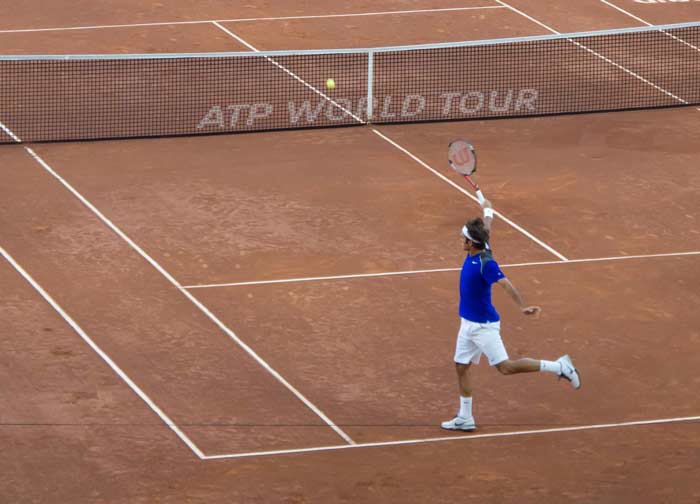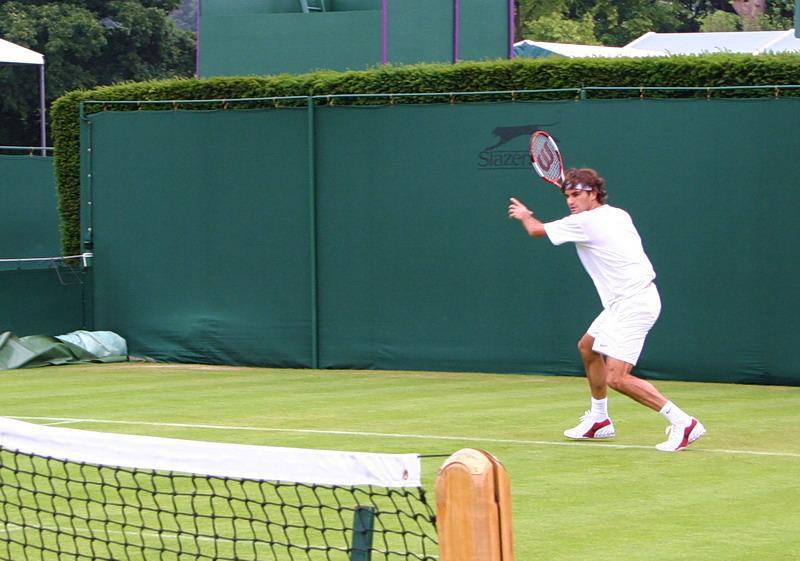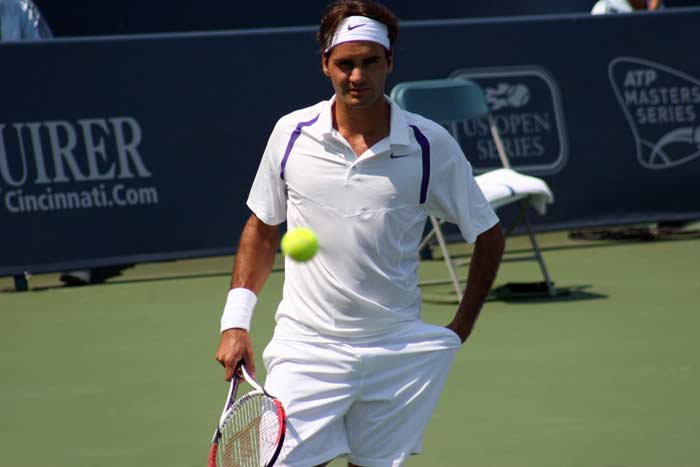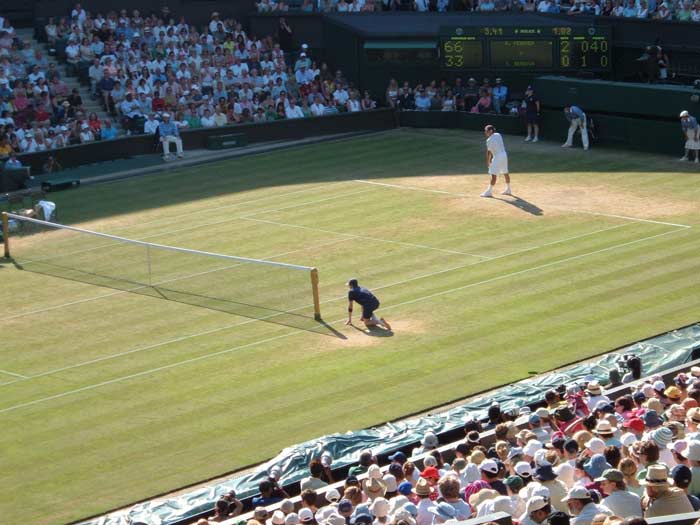5 Skills That Set Roger Federer Apart From The Rest
Who comes to mind when you think of the world’s greatest male athletes?
Michael Jordan… | Muhammad Ali… | Babe Ruth… | Tiger Woods.
These are men who have transcended their sports to become cultural icons. They are symbols of greatness, symbols of what humans performing at the highest levels can achieve, and symbols of what is possible.
Roger Federer will also be included on this list if you’re a tennis fan. After winning Wimbledon for a record 8th time, Federer has cemented himself as one of, if not the greatest tennis player ever to walk the earth. With over 100 total victories during his career, it’s hard to argue with anyone who puts him at the top of the tennis pantheon.

Even Rafael Nadal, one of Federer’s greatest opponents, once said about him, “If anyone says I am better than Roger, then he doesn’t know anything about tennis.”
Like other great athletes, Federer is more than an athlete. But he is undoubtedly an incredible tennis player. He has turned tennis into something beautiful—an art form or dance of sorts.
Preethi Ramamoorthy wrote this regarding Federer:
In Plato’s scheme, truth and beauty are closely related. And Federer’s tennis has always been described as beautiful. John McEnroe, the sport’s previous presiding genius, once called him “the most perfect player” — almost suggesting that this is how the game should be played.
What is it that sets Federer apart from others on the court? Why has he been so successful? What skills does he employ that makes him so good?
Here are five reasons Federer has been so successful.
#1 – The Eastern Grip

Unlike most amateur tennis players, who use a semi-Western Grip, Federer holds his racket with a modified version of the Eastern Grip.
The modified Eastern Grip allows Federer to transition quickly between forehand and backhand during volleys. It also allows him to flatten out his shots more efficiently, reducing their topspin.
Shots with less topspin don’t bounce as high, which makes them more difficult for opponents to track down.
#2 – An Open Stance
A player’s stance dictates how he stands in relation to the baseline. An open stance is with both feet parallel to the baseline, a neutral stance is with the feet perpendicular to the baseline, and a closed stance is with the front leg slightly crossed in front of the back leg.
Federer almost always employs a primarily open stance, which gives him a full, unhindered view of the entire court.
However, using such a stance requires an enormous amount of core strength since he must rotate his entire torso through his stroke. At the conclusion of his stroke, his right shoulder faces his opponent, meaning he rotates 90+ degrees on every stroke.
#3 – Economy of Movement

Federer’s most recent victory came at age 35, which is amazing given that most athletes peak in their mid to late 20s. His success, in some measure, is probably due to his ability to cover the court with minimal movement.
In 2015, Federer covered the least distance per point among the big four (Murray, Nadal, Djokovic, Federer), at only 9.7 meters per point.
This economy of movement allows Federer to preserve energy during his matches. This minimal energy expenditure is increasingly essential if a match goes long.
As others have pointed out, the impression is of weightlessness and gliding. McEnroe is fond of saying that Federer’s exceptionally light footwork has prevented him from injuring his knees on the hard court, like his rival Nadal and so many other men on the tour. McEnroe also likes to compare Fed’s footwork to Baryshnikov’s and to ballet in general.
#4 – A Superb Forehand
Federer’s forehand is his weapon of choice. It is the sword with which he dispatches his enemies, cutting them down with cold-hearted efficiency. He can use it in a befuddling number of ways, sometimes playing heavy, other times playing flat, and still other times playing fast.
Federer’s ability to mix up his forehand constantly keeps his opponents off balance. He avoids set patterns, which prevents opponents from knowing where and how he will hit the ball.
Just how much does Federer rely on his forehand? As The Telegraph notes:
Roger Federer’s forehand unleashes hell like no other. It sounds like a cannon going off: the fluid, racquet-head speed is off the charts. In the five years from 2000-2014 at the London Tour finals, 73% of Federer’s winners from the baseline were forehands (23% backhand). At every opportunity, Federer will run around a backhand in the advantage court to upgrade to a forehand.
What’s essential to note is the technique behind Federer’s forehand. Before unleashing his forehand, he first positions his body correctly, ensuring his core, shoulders, and racket are appropriately positioned.
Then, using a compact and fluid takeback, followed by a full core rotation, he powers his entire body through the ball, driving it at his opponent with incredible force.
Notice the fluid, whiplike motion of his racket as it hits the ball. As one tennis coach notes:
As Federer prepares to meet the ball, his forehand is usually noted for having an extreme acceleration in the last 18 inches before contact is made.
This is due in large part to the position of his wrist, which is bent almost entirely back from the racquet, ensuring another whip-like component that will add punch to the shot. That position of the wrist will also give Federer the option to hit his inside-out forehand if he so chooses.
Federer employs a variety of tactics with his forehand, using it to move his opponents all over the court, tiring them out and keeping them off balance.
Many times, he uses a crosscourt forehand to push his opponents to one side, then drives it down the line with another forehand. Alternatively, he can send it crosscourt again using a backhand or inside out forehand. The effect is that his opponents find themselves exhausted and confused as to where the ball will go.
#5 – A Strong Backhand

Federer also has a unique backhand that generates far more spin than that of his rivals. For comparison:
- Federer – 5,300 RPM (Revolutions Per Minute)
- Nadal – 4,300 RPM
- Djokovic – 2,800 RPM
- Murray – 2,500 RPM
Federer’s backhand, which markedly improved after his injury in 2016, was one of the key reasons he recently beat Nadal, who had previously been able to take advantage of Federer’s backhand.
I think I’ve gotten confident, a lot of practice at the end of the season. Then, when I started to play again at the beginning of the year, I could step into the court and drive the backhand more frequently than ever. I used to use different tactics by slicing more [and] then going big on the second shot, but I’ve turned it around to some extent.
Conclusion
While watching Federer, it can be easy to forget how much time and sweat he has put into becoming the greatest.
Speaking of the greatest musicians in the world, Malcolm Gladwell said:
Once a musician has enough ability to get into a top music school, the thing that distinguishes one performer from another is how hard he or she works. That’s it. And what’s more, the people at the top don’t work harder or even harder than everyone else. They work much, much harder.
The same can be said of athletes like Federer. All we see is the man effortlessly gliding around the court, striking the ball with precision and grace. We don’t see the 10,000 hours of practice – the blood, sweat, and tears.
Perhaps all of us owe Federer a word of thanks. It’s a privilege to watch him play.
Thanks for visiting our site; check out all our FREE tennis drills and courses at the links in the upper menu bar!
Want more from us? Start your $1 trial offer and get FULL ACCESS to our famous 2,000+ tennis drills library for 14 days – CLICK HERE.